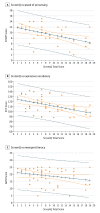Associations Between Screen-Based Media Use and Brain White Matter Integrity in Preschool-Aged Children
- PMID: 31682712
- PMCID: PMC6830442
- DOI: 10.1001/jamapediatrics.2019.3869
Associations Between Screen-Based Media Use and Brain White Matter Integrity in Preschool-Aged Children
Erratum in
-
Change to Open Access Status.JAMA Pediatr. 2020 May 1;174(5):509. doi: 10.1001/jamapediatrics.2020.0529. JAMA Pediatr. 2020. PMID: 32202591 Free PMC article. No abstract available.
Abstract
Importance: The American Academy of Pediatrics (AAP) recommends limits on screen-based media use, citing its cognitive-behavioral risks. Screen use by young children is prevalent and increasing, although its implications for brain development are unknown.
Objective: To explore the associations between screen-based media use and integrity of brain white matter tracts supporting language and literacy skills in preschool-aged children.
Design, setting, and participants: This cross-sectional study of healthy children aged 3 to 5 years (n = 47) was conducted from August 2017 to November 2018. Participants were recruited at a US children's hospital and community primary care clinics.
Exposures: Children completed cognitive testing followed by diffusion tensor imaging (DTI), and their parent completed a ScreenQ survey.
Main outcomes and measures: ScreenQ is a 15-item measure of screen-based media use reflecting the domains in the AAP recommendations: access to screens, frequency of use, content viewed, and coviewing. Higher scores reflect greater use. ScreenQ scores were applied as the independent variable in 3 multiple linear regression models, with scores in 3 standardized assessments as the dependent variable, controlling for child age and household income: Comprehensive Test of Phonological Processing, Second Edition (CTOPP-2; Rapid Object Naming subtest); Expressive Vocabulary Test, Second Edition (EVT-2; expressive language); and Get Ready to Read! (GRTR; emergent literacy skills). The DTI measures included fractional anisotropy (FA) and radial diffusivity (RD), which estimated microstructural organization and myelination of white matter tracts. ScreenQ was applied as a factor associated with FA and RD in whole-brain regression analyses, which were then narrowed to 3 left-sided tracts supporting language and emergent literacy abilities.
Results: Of the 69 children recruited, 47 (among whom 27 [57%] were girls, and the mean [SD] age was 54.3 [7.5] months) completed DTI. Mean (SD; range) ScreenQ score was 8.6 (4.8; 1-19) points. Mean (SD; range) CTOPP-2 score was 9.4 (3.3; 2-15) points, EVT-2 score was 113.1 (16.6; 88-144) points, and GRTR score was 19.0 (5.9; 5-25) points. ScreenQ scores were negatively correlated with EVT-2 (F2,43 = 5.14; R2 = 0.19; P < .01), CTOPP-2 (F2,35 = 6.64; R2 = 0.28; P < .01), and GRTR (F2,44 = 17.08; R2 = 0.44; P < .01) scores, controlling for child age. Higher ScreenQ scores were correlated with lower FA and higher RD in tracts involved with language, executive function, and emergent literacy abilities (P < .05, familywise error-corrected), controlling for child age and household income.
Conclusions and relevance: This study found an association between increased screen-based media use, compared with the AAP guidelines, and lower microstructural integrity of brain white matter tracts supporting language and emergent literacy skills in prekindergarten children. The findings suggest further study is needed, particularly during the rapid early stages of brain development.
Conflict of interest statement
Figures



Comment in
-
Science Has Not Proven That Screen Use Impacts Children's Brain Development.JAMA Pediatr. 2020 Aug 1;174(8):804. doi: 10.1001/jamapediatrics.2020.0625. JAMA Pediatr. 2020. PMID: 32744633 No abstract available.
-
Science Has Not Proven That Screen Use Impacts Children's Brain Development.JAMA Pediatr. 2020 Aug 1;174(8):805. doi: 10.1001/jamapediatrics.2020.0635. JAMA Pediatr. 2020. PMID: 32744634 No abstract available.
-
Science Has Not Proven That Screen Use Impacts Children's Brain Development-Reply.JAMA Pediatr. 2020 Aug 1;174(8):805-807. doi: 10.1001/jamapediatrics.2020.0628. JAMA Pediatr. 2020. PMID: 32744635 No abstract available.
References
-
- Groundbreaking study examines effects of screen time on kids [transcript]. 60 Minutes CBS television. December 9, 2018.
-
- Rideout V. The Common Sense Census: Media Use by Kids Age Zero to Eight. San Francisco, CA: Common Sense Media; 2017.
-
- AAP Council on Communications and Media Media and Young Minds. Elk Grove Village, IL: American Academy of Pediatrics; 2016.
Publication types
MeSH terms
LinkOut - more resources
Full Text Sources
Medical
Miscellaneous

